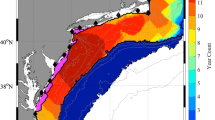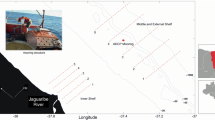Abstract
We examine records from current meters deployed over western Norwegian shelf and slope during the period of 1976 to present. Though many of the records are shorter than six months, when taken together they yield a coherent picture of the field. The mean flow is dominated by the Norwegian Atlantic Current (NwAC) near the shelfbreak, with surface velocities of order 60 cm/sec. The variance is surface-intensified and increases with water depth over the shelf, but is more homogeneous on the slope and just offshore. The variability is strongly seasonal over the shelf but much less so over the slope. Autocorrelations suggest short temporal (1–3 days) and spatial (10–20 km) scales, consistent with deformation-scale eddies. There is evidence for a long range (O|100|km) correlation at the shelfbreak, in the core of the NwAC; otherwise the variability is strongly localized.











Similar content being viewed by others
Notes
We know however that topography exerts a strong influence on the time-varying currents here (Isachsen et al. 2003), and this may in turn affect the path of the mean flow.
In the shallowest regions, only instruments in the upper half of the water column were used for the shallow statistics, to avoid overlap with the deep instruments.
The projection was made onto the etopo5 topographic data set, smoothed to remove scales smaller than about 15 km. As such, the along-isobath direction will differ somewhat from reality, depending on the location.
The PDF is normalized. To evaluate the actual strength of the currents, one must know the standard deviation, as shown in Fig. 6.
References
Bracco A, LaCasce JH, Provenzale A (2000) Velocity PDFs for oceanic floats. J Phys Oceanogr 30:461–474
Enfield DB, Allen JS (1983) The generation and propagation of sea level variability along the Pacific coast of Mexico. J Phys Oceanogr 13:1012–1033
Isachsen PE, LaCasce JH, Mauritzen C, Hakkinen S (2003) Wind-forced barotropic flow in sub-polar regions. J Phys Oceanogr 33:2534–2550
LaCasce JH (2005) On the Eulerian and Lagrangian velocity distributions in the North Atlantic. J Phys Oceanogr (in press)
LaCasce JH, Brink KH (2000) Geostrophic turbulence over a slope. J Phys Oceanogr 30:1305–1324
Mauritzen C (1996) Production of dense overflow waters feeding the North Atlantic across the Greenland-Scotland Ridge. Part 1: evidence for a revised circulation scheme. Deep-Sea Res I 43:769–806
Orvik KA, Niiler P (2002) Major pathways of Atlantic Water in the northern North Atlantic and Nordic Seas toward Arctic. Geophys Res Lett 29(19):1896
Poulain PM, Warn-Varnas A, Niiler PP (1996) Near-surface circulation of the Nordic Seas as measured by Lagrangian drifters. J Geophys Res 101:18237–18258
Press WH, Teukolshy SA, Vetterling WT, Flannery BP (1992) Numerical recipes in FORTRAN: The art of scientific computing. Cambridge University Press, p 963
Rhines PB (1970) Edge-, bottom- and Rossby waves in a rotating, stratified fluid. Geophys Fluid Dyn 1:273–302
Sawford BL (1991) Reynolds number effects in Lagrangian stochastic models of turbulent diffusion. Phys Fluids A 3(6):1577–1584
Skagseth Ø, Orvik KA (2002) Identifying fluctuations in the Norwegian Atlantic Slope current by means of empirical orthogonal functions. Cont Shelf Res 22:547–563
Vallis GK, Maltrud ME (1993) Generation of mean flows and jets on a beta-plane and over topography. J Phys Oceanogr 24:1346–1362
Acknowledgments
The work was supported under a grant from the Norwegian Deep Water Program (NDP) by Norske Shell and by the Ormen Lange license by Norsk Hydro. Further support was provided by the NOCLIM program, funded by the Norwegian Research Foundation. The data were collected and archived under NDP, except for the Svinøy data, which were graciously provided by K.A. Orvik, University of Bergen. C. Mauritzen provided useful input on the local circulation and commentary from two anonymous reviewers helped improve the manuscript.
Author information
Authors and Affiliations
Corresponding author
Additional information
Responsible Editor: Phil Dyke
Rights and permissions
About this article
Cite this article
LaCasce, J.H. Statistics of low frequency currents over the western Norwegian shelf and slope I: current meters. Ocean Dynamics 55, 213–221 (2005). https://doi.org/10.1007/s10236-005-0021-6
Received:
Accepted:
Published:
Issue Date:
DOI: https://doi.org/10.1007/s10236-005-0021-6




